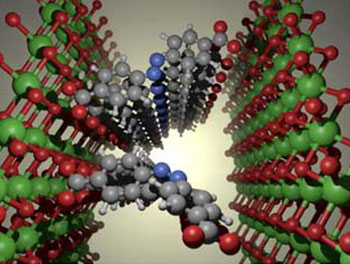| Posted: Aug 19, 2014 |
Scientists describe a hybrid laminate material with magnetic and photoactive properties
|
|
(Nanowerk News) A research conducted by the Institute for Molecular Science of the Universitat de València and of the Institute for Chemical Technology of the Universitat Politècnica de València and the Spanish National Research Council, confirms for the first time the possibility of modulating the magnetic properties of an inorganic material through organic photoactive molecules activated by light.
|
 |
| Valencian scientists describe a hybrid laminate material with magnetic and photoactive properties.
|
|
The scientists of the Institute for Molecular Science of the University of Valencia, Gonzalo Abellán, Eugenio Coronado, Carlos Martí and Antonio Ribera, along with the researchers Hermenegildo García and José Luis Jordá of the Institute for Chemical Technology (Universitat Politècnica de València- Spanish National Research Council), have developed an study that has become one of the most successful approaches for obtaining new hybrid materials chemically designed.
|
|
The study and research on multifunctional hybrid materials is one of the hot topics of numerous research groups worldwide. Our scientists have succeeded in synthesizing a hybrid laminar material in which magnetic properties based on hydroxides have been modulated, thanks to the size changes produced in azo molecules under the effect of a light stimulus.
|
|
In an excitement with ultraviolet light of azo molecules, the inorganic matrix layers decrease its distance and, therefore, the magnetic properties. The hybrid laminar material can return to its original properties when is exposed to water or to certain air humidity, by the fact that the initial distance between the inorganic matrix layers is recovered.
|
|
The success of this research has been based on the interleaving of photoactivatable anionic molecules into the interlamellar space of the inorganic matrix and on achieving the trans-cis isomerization reaction in solid state within the nanometric space left between the layer.
|
|
Thanks to this research the path for modulating the magnetic properties of a material is open, applying external stimulus like for example to light, heat and humidity, etc. Thus it is demonstrated that the combination of two components involves more than the simple linkage of functionalities, and which acquire, by a cooperative mechanism new properties not previously achieved, which offers a wide range of possibilities like in the field of spintronics or sensors. These results were published last June in the issue 24 of the journal Advanced Materials ("Photo-Switching in a Hybrid Material Made of Magnetic Layered Double Hydroxides Intercalated with Azobenzene Molecules").
|
|
This research, in which our researchers (“Functional Nanomaterials and nano-devices” Research Microcluster) have participated, constitutes an important advance towards chemical design of a great range of functional hybrid materials through the deliberate choice of a matrix that acts as a guest of the physical properties of the molecules interjected as hosts.
|
|
The research has been conducted in the frame of the VLC/ Campus. Valencia, International Campus of Excellence integrated by the University of Valencia, the Universitat Politècnica de València and the Spanish National Research Council (CSIC), and has been funded by the Ministry of Education, Culture and Sports, under the programme International Campus of Excellence, that facilitates a greater collaboration between the three research entities.
|

